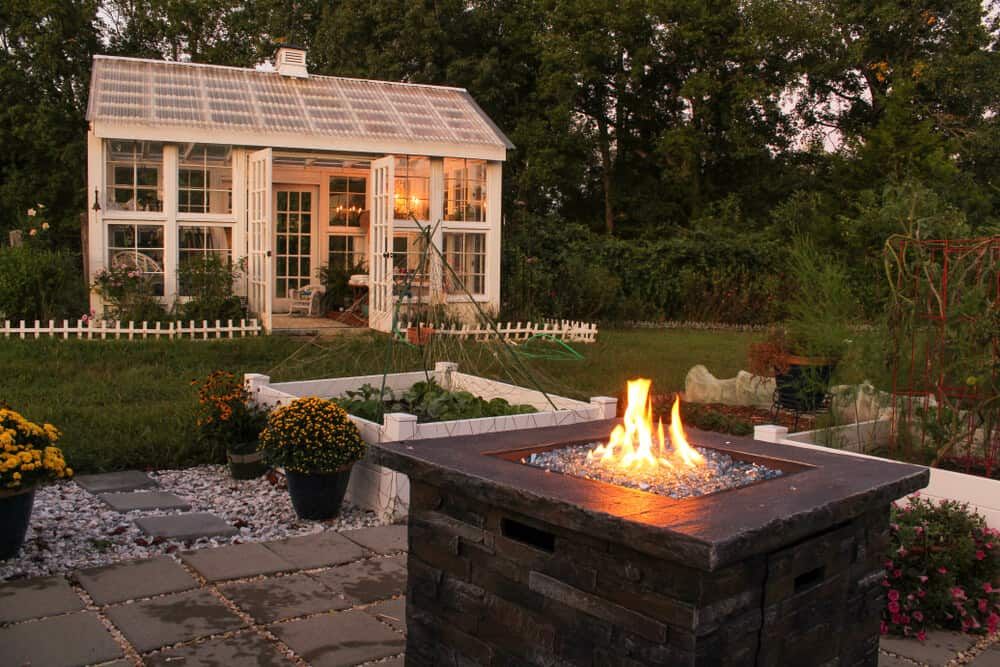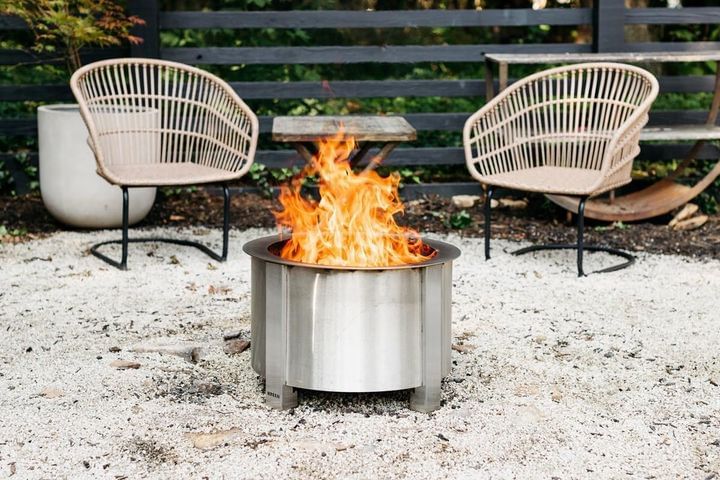Call us at 725-239-9966!
M-F: 8 AM-7 PM PST
Call us at 725-239-9966!
M-F: 8 AM-7 PM PST

Traditional outdoor wood fire pits come with a major drawback: smoke. Breathing in all that smoke while you're trying to relax and enjoy time around the fire is not ideal. This is where smokeless fire pits come in - offering you the atmosphere and ambiance of a real wood fire, without the smoke ruining the experience.
Smokeless fire pits burn wood with less smoke using a double-wall design and engineered airflow.
The gap between walls allows air to enter vents, heat up, and facilitate secondary combustion to burn smoke into heat and light.
Benefits include less smoke, better efficiency, portability, and the ability to be used during burn bans.
Drawbacks compared to traditional fire pits include higher costs, less radiant heat, and smaller capacities.

A smokeless fire pit is a specially designed outdoor fire pit that burns wood or other solid fuels in a way that produces very little smoke. While no fire pit can be 100% smoke-free, smokeless fire pits use technology like double walls, air vents, and fans to allow secondary combustion of gases and particulates, drastically reducing the amount of visible smoke exiting the fire pit.
Smokeless fire pits achieve a cleaner, smoke-reduced burn through a patented design that optimizes airflow and combustion. Here are the key components that make them work:
The carefully engineered airflow allows the fire to burn hotter, faster, and cleaner. Supporting the wood on a perforated steel log grate also improves air circulation and reduces smoking.

There are several key reasons you might want to choose a smokeless fire pit rather than a traditional wood-burning one:
The main benefit of a smokeless fire pit is right there in the name - you get to enjoy a beautiful real wood fire with less smoke. No more stinging eyes or smelling like a campfire for days afterward. This makes smokeless fire pits ideal for urban and suburban areas where excess smoke could bother neighbors.
Breathing in smoke from open fires can irritate lungs and aggravate conditions like asthma. Smoke contains small particulate matter, carbon monoxide, and other compounds that are unhealthy to ingest. Smokeless fire pits help minimize contact with these pollutants.
Less smoke means more heat energy stays trapped in the fire chamber. Smokeless fire pits burn hotter while using less fuel. The convection airflow also causes heat to rise and radiate outwards from the entire pit surface, helping warm your seating area.
Many areas prohibit open burning during dry conditions to reduce fire hazards. But smokeless fire pits often qualify as cooking devices, which are exempt. So you can still enjoy backyard fires even when general burning is banned. Just check your local ordinances first.
Smokeless fire pit models range from compact, portable sizes to larger permanent backyard installations. Their efficient burn means you can enjoy smoke-free warmth anywhere from RVs to high-rise patios.
The ambiance of an evening fire brings people together. But lingering campfire smell in clothes and hair can be undesirable. Smokeless technology lets everyone socialize around the vibrant flame without being smoked out.

If you're deciding between smokeless and conventional fire pits, here are some key comparisons to consider:
Smoke - This is the standout difference. Smokeless pits reduce smoke a lot. But they still produce some smoke, especially when starting/extinguishing the fire.
Heat Output - Smokeless models burn hotter but condense heat rather than radiating widely like traditional pits. You may need to sit closer to feel the warmth.
Fuel Efficiency - Less smoke means the fire converts more wood fully to energy. Smokeless pits use less fuel for the same heat duration.
Cost - Smokeless fire pits range from $200 to $600 while basic traditional ones cost between $50 and $300. The advanced design comes at a price.
Emissions - Smokeless technology cuts down on harmful emissions, making it better for the environment.
Aesthetics - Traditional pits have a rugged, rustic vibe while smokeless models look more sleek and contemporary. It's about personal style.
| Smokeless | Traditional | ||
|---|---|---|---|
| Smoke Production | Less smoke | More smoke | |
| Heat Output | Hotter fire, less radiation | Lower temp, more radiation | |
| Fuel Efficiency | Uses less wood overall | Uses more wood | |
| Cost | $$$-$$$$ | $-$$ | |
| Emissions | Fewer harmful particulates | Higher emissions | |
| Aesthetics | Sleek and contemporary | Rustic campfire feel |
For urban or suburban areas where smoke is a concern, smokeless models are likely the better choice. In rural areas, traditional fire pits may be preferred for their cost and campfire ambiance.
As with any product, smokeless fire pits come with pluses and minuses to weigh based on your needs. For many homeowners, the benefits of reduced smoke and healthier fires make smokeless models well worth the investment.
Here are some things to think about when deciding if a smokeless fire pit is the right choice for your needs:
Do you want to enjoy a fire pit regularly but find smoke irritating? Smokeless technology can create a smoke-free outdoor experience.
Is your outdoor living space in a smoke-sensitive area? Smokeless pits allow having fires where traditional fire pits aren’t permitted.
Are you willing to pay more upfront for a unit you’ll use frequently? The benefits can provide great value over time.
Do you need massive capacity for huge bonfires? Smokeless models have size limitations so you can prefer traditional ones.
Do you prioritize portability for camping trips or moving around your yard? Many smokeless fire pits are lightweight.
Does authentic wood fire ambiance matter most? Traditional wood-burning fire pits may provide a better campfire aesthetic.
If you've decided a smokeless fire pit is the right choice for your backyard or patio, the next step is selecting the best model for your needs and budget. Be sure to consult our detailed fire pit buying guide for advice on choosing the right size, features, and options before purchasing your new smokeless fire pit.

Smokeless fire pits use innovative airflow technology to burn wood and solid fuels with less smoke than usual. Key design features like an insulated double wall, vents, and grated fuel support allow oxygen to ignite rising smoke particulates through secondary combustion. This advanced incineration leaves minimal smoke emissions and maximizes heating efficiency. While pricier than basic fire pits, for urban areas or health concerns, they can be a worthy investment to gain the beauty of a crackling backyard fire with barely any smoke.
Yes, smokeless fire pits are versatile and often come with an accessory like a BBQ grate for fire pit. The Breeo, for instance, is well-suited for a campfire cookout or tailgate barbecue. The amount of smoke generated is so minimal you’ll hardly notice it, ensuring your food doesn't taste excessively smokey.
No, one of the advantages of a smokeless fire pit’s unique design is that it requires less fuel than a regular fire. The design promotes better air, allowing the firewood to burn more completely and efficiently.
Yes, smokeless fire pits are safe when used properly. Their unique design reduces the risk of sparks flying out, and the double-walled construction ensures the outer ring of the fire pit remains cooler, reducing the risk of accidental burns.
Absolutely. Smokeless fire pits give off heat just as a regular fire would. Thanks to the complete combustion process, they can actually produce a hotter, more consistent heat, making them perfect for sitting around on a cool evening.
Yes, you can upgrade your existing wood fire pit to become smokeless by adding a fire pit insert. The insert works by improving the airflow which aids in the combustion process, effectively reducing the amount of smoke produced. If you’re looking to convert your pit, make sure you’ve chosen an insert that fits your current pit size.
While wood is the most commonly used fuel, some smokeless fire pits are designed to work with other fuels like propane. Propane burns very efficiently and produces virtually no smoke. However, using different fuels may require specific accessories or features, so it's best to check with the manufacturer's specifications.

0 of 3 items selected
Leave a comment